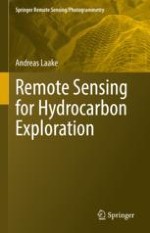Abstract
Rendering is an essential task to view remote sensing data for interpretation and modeling. We will study three different realizations of spatial rendering:
Flat maps without vertical exaggeration and perpendicular illumination.
With this rendering method, the remote sensing data are represented like maps with the advantage that accurate measurements can be taken for geospatial mapping and planning. This approach is widely used in geographic information systems (GIS).
Flat maps with vertical exaggeration and slant illumination.
To realize this method, a digital relief model is required onto which the remote sensing data are mapped or projected. We call this process draping the image. The vertical exaggeration then offers to the option to introduce illumination from the side to create the visual impression of a 3D effect, whilst the data still remain in map view. This approach is beneficial for structural analysis when 3D distortion from parallax is not acceptable. One version with pre-defined vertical exaggeration and slant illumination is implemented in GIS as hill-shading, for example in topographic maps.
3D rendering with vertical exaggeration and slant illumination.
This approach also requires a digital relief model on which to drape the remote sensing data. Vertical exaggeration and slant illumination create a virtual reality impression that lets interpreters experience the data as if they were immersed in the landscape. The use of slant illumination with multiple light sources enhances the virtual reality impression because it creates the impression of diffuse light which creates a very real impression.
A second important aspect of rendering is the use of color to emphasize features for interpretation. For single data sets, colormaps assist in making certain geologic features accessible to the interpretation. For multiple co-located data sets such as multi-spectral remote sensing data the co-rendering of three bands in RGB is a powerful method because it allows to merge the expression of features on different spectral bands whilst preserving specific properties in color.
